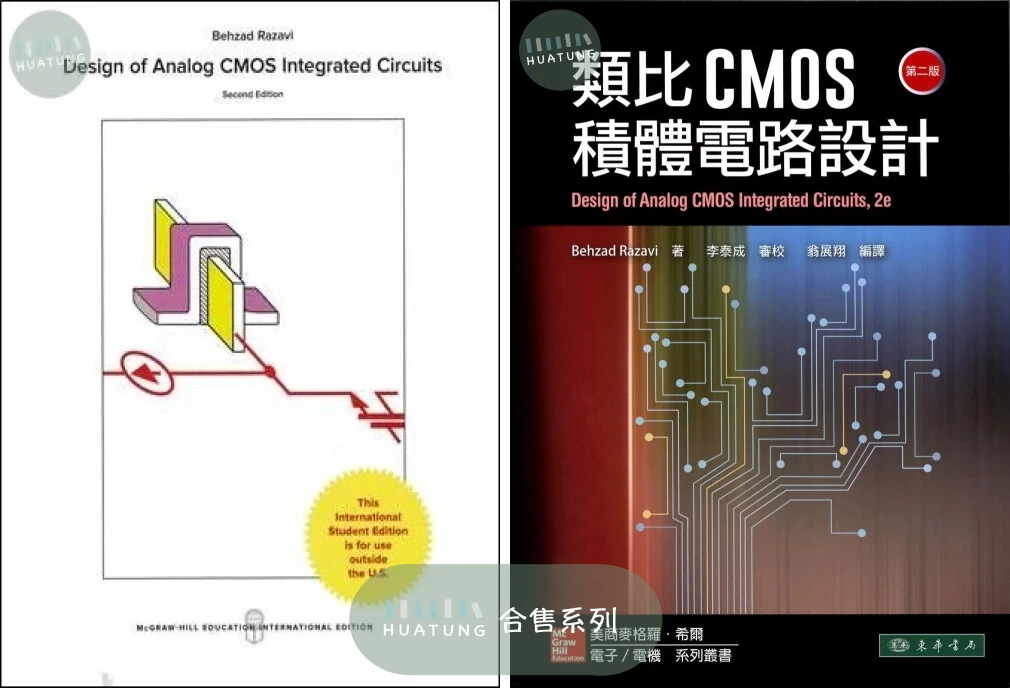
| 定價: | ||||
| 售價: | 1550元 | |||
| 庫存: | 已售完 | |||
| LINE US! | ||||
| 此書為本公司代理,目前已售完,有需要可以向line客服詢問進口動向 | ||||
| 付款方式: | 超商取貨付款 |

|
|
| 信用卡 |

|
||
| 線上轉帳 |

|
||
| 物流方式: | 超商取貨 | ||
| 宅配 | |||
| 門市自取 |
為您推薦

類似書籍推薦給您
【簡介】 【目錄】 Chapter 1 Models for Integrated-Circuit Active Devices Chapter 2 Bipolar, MOS, and BiCMOS Integrated-Circuit Technology Chapter 3 Single-Transistor and Multiple-Transistor Amplifiers Chapter 4 Current Mirrors, Active Loads, and References Chapter 5 Output Stages Chapter 6 Operational Amplifiers with Single-Ended Outputs Chapter 7 Frequency Response of Integrated Circuits Chapter 8 Feedback Chapter 9 Frequency Response and Stability of Feedback Amplifiers Chapter 10 Nonlinear Analog Circuits Chapter 11 Noise in Integrated Circuits Chapter 12 Fully Differential Operational Amplifiers

類似書籍推薦給您
【簡介】 In 2006, the Signal Processing Department at Blekinge Institute of Technology and Axiom EduTECH in Sweden worked with National Instruments Corporation in Texas, USA, to set up the Virtual Instrument Systems in Reality (VISIR) Project, which operates as a remote laboratory for electric and electronic circuits. The VISIR remote laboratory is currently the only system that delivers practical experiments with electronics without the need to go to a traditional lab. This is of increasing importance given the expansion of online education. There is a mass of scientific literature that collects results on the use of VISIR remote laboratory, however, there are few reference works that provide an in-depth exploration of the laboratory's performance and potential. VISIR Handbook acts as a guide for users, demonstrating many of the real (remote) experiments that can be achieved and replicated with this laboratory. Most importantly, this book demonstrates how VISIR can be used as a learning tool for students. The approach of the book is designed on two levels, with an administrator/researcher approach and a teacher/student approach. 【目錄】

類似書籍推薦給您

類似書籍推薦給您

類似書籍推薦給您
"This textbook is for a first course on electronics. It assumes no prior electronics experience, but does assume that students have had calculus 1 (single-variable differential calculus) and high-school physics. A key idea of the course is that students need a lot of design experience and hands-on work, rather than a lot of theory. The course is centered around the labs, which are a mix of design labs and measurement/modeling labs. This unique volume takes students from knowing no electronics to being able to design and build amplifier and filter circuits for connecting sensors to microcontrollers within 20 weeks. Students design a digital thermometer, a blood-pressure meter, an optical pulse monitor, an EKG, an audio preamplifier, and a class-D power amplifier. They also learn how to measure and characterize components, including impedance spectroscopy of a loudspeaker and of electrochemical electrodes. Related Link(s) Press Release — Hands-on approach to learning analog electronics opens design to more students Request Inspection Copy Sample Chapter(s) Preface FRONT MATTER Chapter 1: Why an Electronics Class? Chapter 2: Background Material Chapter 22: Optoelectronics Chapter 25: Lab 6: Optical Pulse Monitor Chapter 41: Electrocardiograms (EKGs) Chapter 42: Lab 13: EKG BACK MATTER Contents: Why an Electronics Class? Background Material Lab 1: Setting Up Voltage, Current, and Resistance Voltage Dividers and Resistance-based Sensors Signals Design Report Guidelines Lab 2: Measuring Temperature Sampling and Aliasing Impedance: Capacitors Passive RC Filters Function Generator Debugging Lab 3: Sampling and Aliasing Oscilloscopes Hysteresis Lab 4: Hysteresis Amplifiers Operational Amplifiers Pressure Sensors Lab 5: Strain-Gauge Pressure Sensor Optoelectronics Transimpedance Amplifier Active Filters Lab 6: Optical Pulse Monitor Microphones Lab 7: Electret Microphone Impedance: Inductors Loudspeakers Lab 8: Loudspeaker Modeling Lab 9: Low-Power Audio Amplifier Field-effect Transistors Comparators Lab 10: Measuring FETs Class-D Power Amplifier Triangle-Wave Oscillator Lab 11: Class-D Power Amp Electrodes Lab 12: Electrodes Instrumentation Amps Electrocardiograms (EKGs) Lab 13: EKG PteroDAQ Documentation Study Sheet References Index Readership: Researchers, professionals, academics, undergraduate and graduate students in electrical & electronic engineering, and circuits and systems."